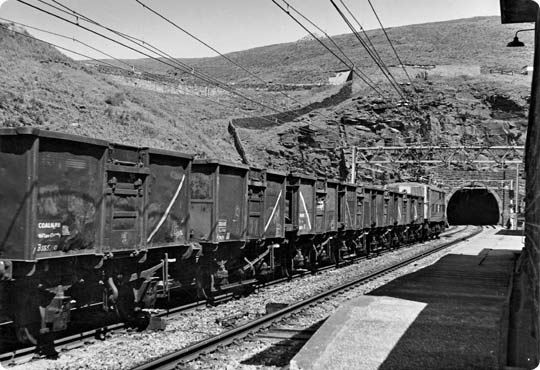Woodhead tunnel: a comedy of errors

- Author: Graeme Bickerdike
- Source: The Rail Engineer
- Published: May 2008
Woodhead tunnel: a comedy of errors
Not surprisingly for one of America’s founding fathers, Benjamin Franklin was so 18th Century. Contrary to his well-worn assertion, death and taxes are no longer life’s only certainties. We’ll write off breathing as a clerical oversight, but today we can surely bet our bottom dollars on spin, inflation, bureaucracy and the presence of Betty’s Hotpot on the Rovers Return menu.
When it comes to the railway, ignorance is prevalent too, especially amongst the media and our political overlords. Recent proclamations on the unfolding Woodhead tunnel saga serve up morcels of evidence.

Photo: Four by Three
In case you’re unfamiliar with this story, the National Grid owns the three former railway tunnels – two Victorian single bores and a concrete product of 1954 – which formerly funnelled trains beneath the hills of the Peak District. Despite benefiting from an early electrification scheme, the Woodhead route fell victim to acute myopia in 1981. NG has power lines through one of the older tunnels, the fabric of which is in decline. A project got underway in January to fit replacement equipment in the 1954 bore after which the singles will be abandoned.
Trouble is, there’s mounting pressure for the railway to be reopened. With a new deep sea facility authorised at Teesport, 60 additional daily train loads of 9’6” containers could be heading to and from the Port of Liverpool by 2030. None of our existing trans-Pennine lines are cleared for W12 traffic so the A19, A1 and M62 can look forward to more ravenous HGVs chewing up their tarmac. Yet the Fifties’ visionaries who built Woodhead did so to European gauge – it offers a ready-made alternative.
The impending loss of the tunnel did not blip on the radar of transport campaigners, environmentalists and politicians until it was too late to do much about it. They have though made a lot of noise, causing uncomfortable shuffling within the Department for Transport. A petition was established on the Downing Street website whilst 77 MPs put their names to an Early Day Motion appealing for intervention to “prevent this strategic rail route being lost forever”. That’s significant support – only 76 signed up for action against Japan’s hunting of whales.
At first glance, this might look like a little local difficulty. That’s over-simplistic. Woodhead is a yardstick against which the Government’s strategic transport vision can be measured. Forecasts point to the North’s economy exerting ever-greater pressure on its road and rail network. The case for a fourth trans-Pennine line – conventional or high-speed – is becoming stronger. The tunnel could prove to be a hugely valuable asset in years to come so isn’t it worth securing for future railway use? Not according to the DfT. It’s detailed plans look no further than 2014.

The arguments are dry and complex, relying on the uncertain science of growth modelling. Still, those of us who’ve kept across this story for the past four months can thank our lucky stars for the comical subplot played out by Ruth Kelly and ministerial sidekick Rosie Winterton who’ve shown an unceasing willingness to open their mouths without first getting their facts straight. It’s been great entertainment.
The Transport Secretary dropped her first clanger on 22nd January when she declared that the presence of power cables “would not preclude reopening the tunnel for freight traffic were the growth of freight traffic to warrant it.” Throngs of health ‘n’ safety nursemaids must have suffered palpitations at the prospect of trains, trackworkers and 400kV all sharing the structure. Officials issued a clarification.
In front of the Transport Select Committee on 30th January, Ms Kelly claimed that the Victorian single bores – in a state of disrepair and of insufficient gauge to accommodate modern containers – could be reopened if there was a business case. Only Northern Rock would invest in that. Full of surprises, she then attempted to redraw the map of our former network. “There is a disused line between London and Birmingham” she announced. “One of the options we might look at in the future is whether we ought to bring that back into use. That line has been safeguarded.” Railway historians scratched their heads to oblivion before admitting defeat. No such line could be found.
Next on stage was Rosie Winterton. During a carefully crafted contribution to a Commons adjournment debate, the Transport Minister reaffirmed her department’s position that “no Government or rail industry strategy or planning document has identified a need for additional rail capacity across the Pennines that would require the reopening of the Woodhead route.” And she was right. The Yorkshire & Humber Regional Transport Strategy, the ageing South Pennines Integrated Transport Strategy and the Northern Way’s Steering Group Growth Strategy – none of which were the direct products of Government or rail industry – identified a future need for another trans-Pennine line without prejudging the optimum route. Woodhead was referred to only as an option.
She went on to delight her audience by agreeing to “meet National Grid in the next few weeks to confirm that the Government wishes to explore further the option of continuing the inspection and maintenance regime for the Victorian tunnels once National Grid has vacated them.” This deliciously vague undertaking came just days after both NG and Network Rail had made it clear that they would not fund that work. Several MPs claimed that the battle had been won – an absurd victory for wishing thinking.
Last month Ms Winterton added a cherry to her cake. In response to a parliamentary question, she explained that “Should additional capacity be required across the Pennines at some future date, capacity enhancements on the three existing Victorian tunnels on the Woodhead route would be considered first. This is because they are more likely to offer value for money than the reopening of a fourth route.” Woodhead, of course, would be a fourth route – she’s minded to increase capacity on a line which doesn’t exist. And where’s this third Victorian tunnel hiding?

Photo: John Ashton
There’s a temptation to despair here. Whilst Europe enjoys all the benefits of investment in new railway, we’re left to make-do-and-mend our 19th Century network. Britain’s transport infrastructure is being stretched beyond its elastic limit. Calls for high speed lines – offering huge financial rewards – have so far fallen on deaf ears. We have climate change obligations which can never be realised without driving a significant modal shift. Where will the extra capacity come from?
It’s fair to contend that saving the Woodhead tunnel would immediately change very little. Allowing it to die perpetuates the notion that our Government remains committed to looking no further than the end of its nose. That’s not an encouraging transport policy. Moreover, the scourge of foot-in-mouth inspires no confidence in our political leadership.





